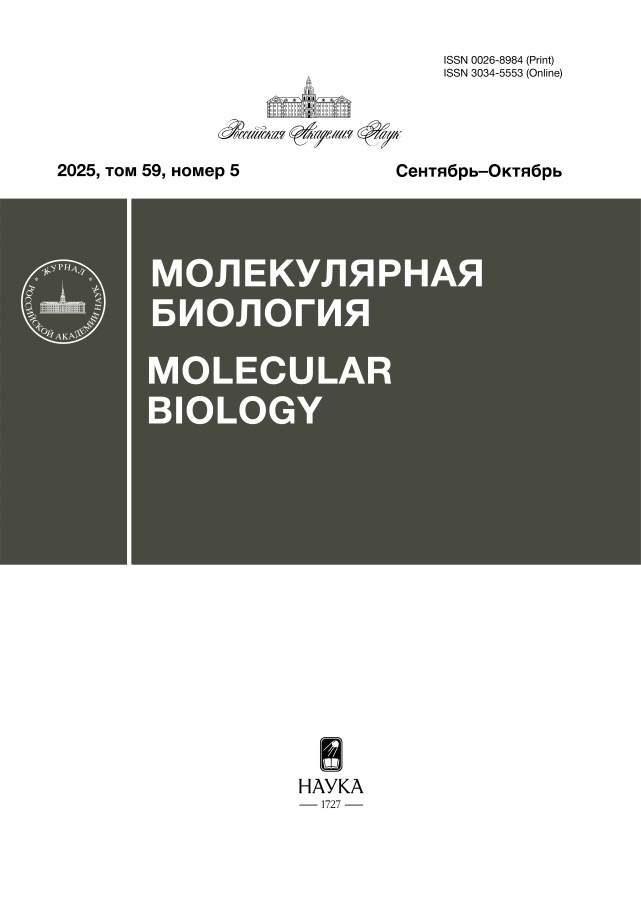Substrate specificity of purine nucleoside phosphorylase E. coli in phosphorolysis reactions of purine ribonucleotides containing a cyclic terpene fragment
- Authors: Kozlova A.A.1, Oslovsky V.E.1, Varga M.A.1, Alexeev C.S.1, Drenichev M.S.1
-
Affiliations:
- Engelhardt Institute of Molecular Biology, Russian Academy of Sciences
- Issue: Vol 59, No 5 (2025)
- Pages: 835-844
- Section: СТРУКТУРНО-ФУНКЦИОНАЛЬНЫЙ АНАЛИЗ БИОПОЛИМЕРОВИ ИХ КОМПЛЕКСОВ
- URL: https://rjsocmed.com/0026-8984/article/view/696391
- DOI: https://doi.org/10.31857/S0026898425050089
- ID: 696391
Cite item
Abstract
About the authors
A. A. Kozlova
Engelhardt Institute of Molecular Biology, Russian Academy of SciencesMoscow, 119991 Russia
V. E. Oslovsky
Engelhardt Institute of Molecular Biology, Russian Academy of SciencesMoscow, 119991 Russia
M. A. Varga
Engelhardt Institute of Molecular Biology, Russian Academy of SciencesMoscow, 119991 Russia
C. S. Alexeev
Engelhardt Institute of Molecular Biology, Russian Academy of SciencesMoscow, 119991 Russia
M. S. Drenichev
Engelhardt Institute of Molecular Biology, Russian Academy of Sciences
Email: mdrenichev@mail.ru, room517@eimb.ru
Moscow, 119991 Russia
References
- Wagner K.-H., Elmadfa I. (2003) Biological relevance of terpenoids. Ann. Nutr. Metab. 47, 95–106.
- Ощепков М.С., Калистратова А.В., Савельева Е.М., Романов Г.А., Быстрова Н.А., Кочетков К.А. (2020) Природные и синтетические цитокинины и их применение в биотехнологии, агрохимии и медицине. Успехи химии. 89, 787–810.
- Sakakibara H. (2010) Plant Hormones: Biosynthesis, signal transduction, action. Springer: Dordrecht, 95–114.
- Voller J., Zatloukal M., Lenobel R., Doležal K., Béreš T., Kryštof V., Spíchal L., Niemann P., Džubák P., Hajdúch M., Strnad M. (2010) Anticancer activity of natural cytokinins: a structure–activity relationship study. Phytochemistry. 71(11–12), 1350–1359.
- Kamada-Nobusada T., Sakakibara H. (2009) Molecular basis for cytokinin biosynthesis. Phytochemistry. 70(4), 444–449.
- Романов Г.А. (2009) Как цитокинины действуют на клетку. Физиология растений. 56(2), 295–319.
- Drenichev M.S., Oslovsky V.E., Mikhailov S.N. (2016) Cytokinin nucleosides-natural compounds with a unique spectrum of biological activities. Curr. Top. Med. Chem. 16(23), 2562–2576.
- Efimtseva E.V., Kulikova I.V., Mikhailov S.N. (2007) Disaccharide nucleosides and their incorporation into oligonucleotides. Curr. Org. Chem. 11, 337–354.
- Rozenski J., Crain P.F., McCloskey J.A. (1999) The RNA modification database: 1999 update. Nucl. Acids Res. 27(1), 196–197.
- Tararov V.I., Tijsma A., Kolyachkina S.V., Oslovsky V.E., Neyts J., Drenichev M.S., Leyssen P., Mikhailov S.N. (2015) Chemical modification of the plant isoprenoid cytokinin N6-isopentenyladenosine yields a selective inhibitor of human enterovirus 71 replication. Eur. J. Med. Chem. 90, 406–413.
- Young D.C., Layre E., Pan S.J., Tapley A., Adamson J., Seshadri C., Wu Z., Buter J., Minnaard A.J., Coscolla M., Gagneux S., Copin R., Ernst J.D., Bishai W.R., Snider B.B., Moody D.B. (2015) In vivo biosynthesis of terpene nucleosides provides unique chemical markers of Mycobacterium tuberculosis infection. Chem. Biol. 22(4), 516–526.
- Oldfield E. (2015) Tuberculosis terpene targets. Chem. Biol. 22(4), 437–438.
- Buter J., Cheng T.Y., Ghanem M., Grootemaat A.E., Raman S., Feng X., Plantijn A.R., Ennis T., Wang J., Cotton R.N., Layre E., Ramnarine A.K., Mayfield J.A., Young D.C., Jezek Martinot A., Siddiqi N., Wakabayashi S., Botella H., Calderon R., Murray M., Ehrt S., Snider B.B., Reed M.B., Oldfield E., Tan S., Rubin E.J., Behr M.A., van der Wel N.N., Minnaard A.J., Moody D.B. (2019) Mycobacterium tuberculosis releases an antacid that remodels phagosomes. Nat. Chem. Biol. 15(9), 889–899.
- Mathews C.K., Van Holde K.E. (1996) Biochemistry. San Francisco: Benjamin Cummings PC.
- Jensen K.F., Dandanell G., Hove-Jensen B., WillemoËs M. (2008) Nucleotides, nucleosides, and nucleobases. EcoSal Plus. 3(1), 1‒39.
- Brown A.M., Hoopes S.L., White R.H., Sarisky C.A. (2011) Purine biosynthesis in archaea: variations on a theme. Biol. Direct. 6, 63.
- Mikhailopulo I.A., Miroshnikov A.I. (2011) Biologically important nucleosides: modern trends in biotechnology and application. Mendeleev Commun. 21(2), 57.
- Mikhailopulo I.A. (2007) Biotechnology of nucleic acid constituents-state of the art and perspectives. Curr. Org. Chem. 11(4), 317–335.
- Kulikova I.V., Drenichev M.S., Solyev P.N., Alexeev C.S., Mikhailov S.N. (2019) Effective preparation of 2-deoxyribose 1-phosphate and ribose-1-phosphate, and their use for enzymatic preparation of nucleosides. Eur. J. Org. Chem. 41, 6999–7004.
- Komatsu H., Araki T. (2005) Efficient chemo-enzymatic syntheses of pharmaceutically useful unnatural 2′-deoxynucleosides. Nucleosides, Nucleotides Nucl. Acids. 24(5–7), 1127–1130.
- Schramm V.L. (2018) Enzymatic transition states and drug design. Chem. Rev. 118(22), 11194‒11258.
- Гордон А., Форд Р. (1976) Спутник химика. Москва: Мир.
- Tararov V.I., Kolyachkina S.V., Alexeev C.S., Mikha- ilov S.N. (2011) N6-Acetyl-2′,3′, 5′-tri-O-acetyladenosine; a convenient, ‘missed out’ substrate for regioselective N6-alkylations. Synthesis. 15, 2483–2489.
- Alhossary A., Handoko S.D., Mu Y., Kwoh C.-K. (2015) Fast, accurate, and reliable molecular docking with QuickVina 2. Bioinformatics. 31, 2214–2216.
- Lewkowicz E.S., Iribarren A.M. (2006) Nucleoside phosphorylases. Curr. Org. Chem. 10(11), 1197‒1215.
- Alexeev C.S., Kulikova I.V., Gavryushov S., Tararov V.I., Mikhailov S.N. (2018) Quantitative prediction of yield in transglycosylation reaction catalyzed by nucleoside phosphorylases. Adv. Synth. Catal. 360(16), 3090‒3096.
- Oslovsky V.E., Solyev P.N., Polyakov K.M., Alexeev C.S., Mikhailov S.N. (2018) Chemoenzymatic synthesis of cytokinins from nucleosides: ribose as a blocking group. Org. Biomol. Chem. 16(12), 2156–2163.
- Kline P.C., Schramm V.L. (1993) Purine nucleoside phosphorylase. Catalytic mechanism and transition-state analysis of the arsenolysis reaction. Biochemistry. 32(48), 13212–13219.
- Xie F., Seifert N.A., Heger M., Thomas J., Jäger W., Xu Y. (2019) The rich conformational landscape of perillyl alcohol revealed by broadband rotational spectroscopy and theoretical modelling. Phys. Chem. Chem. Phys. 21, 15408–15416.
- Holden C.M., Whittaker D. (1975) Conformational studies of monoterpenes. II–conformational studies of bicyclo[3.1.1]heptane derivatives by 13C NMR. Org. Magn. Reson. 7, 125–127.
Supplementary files











